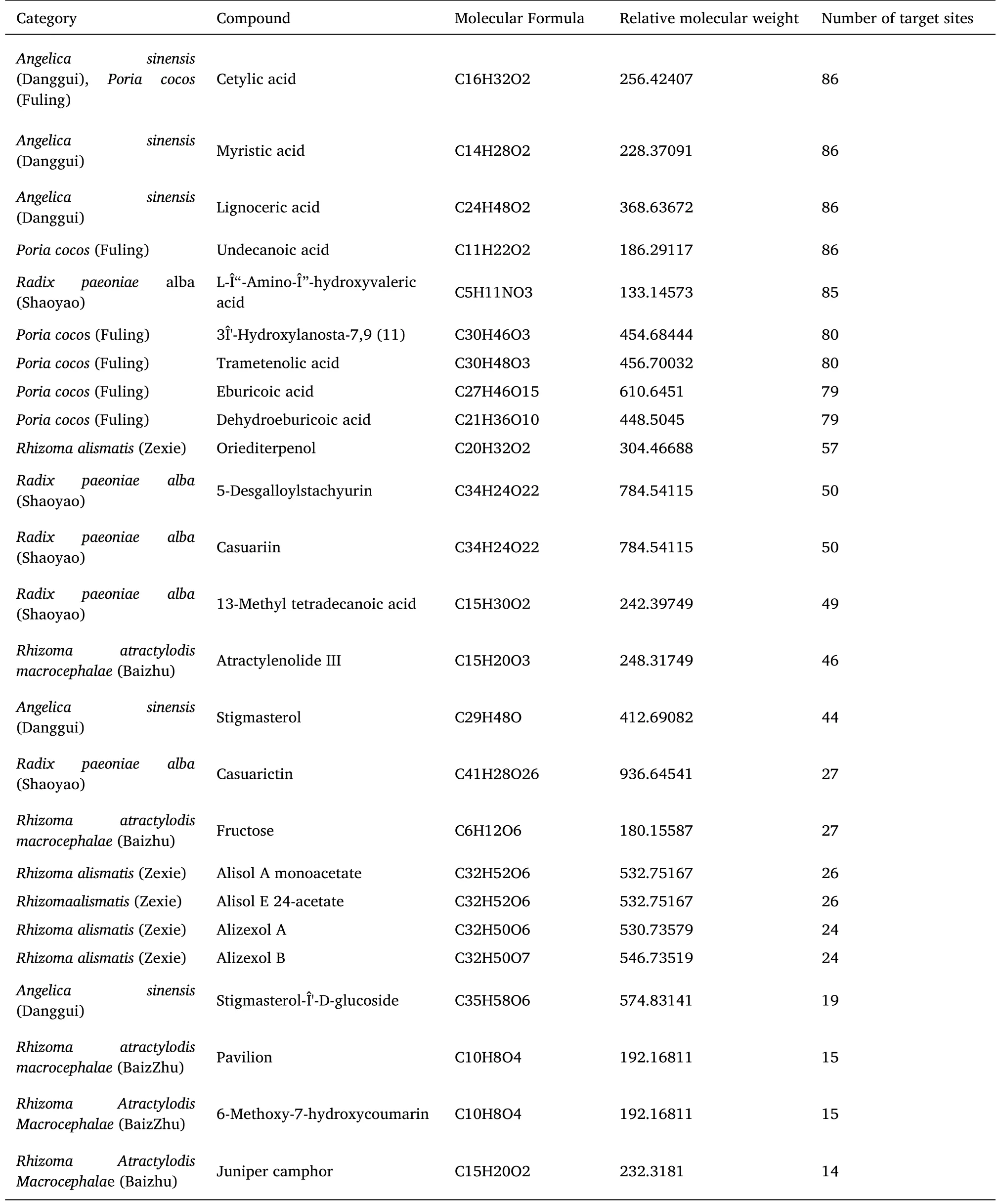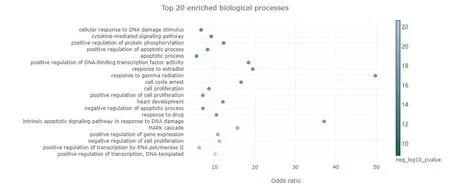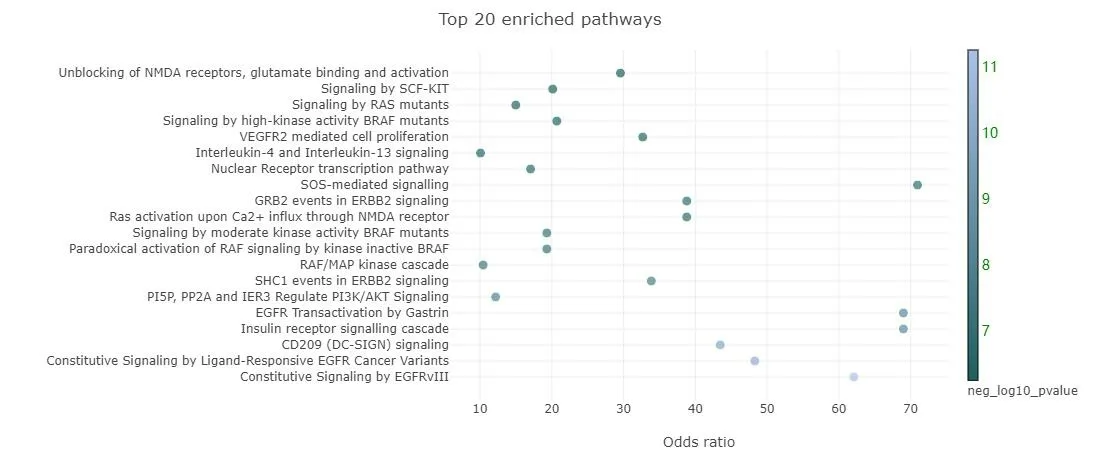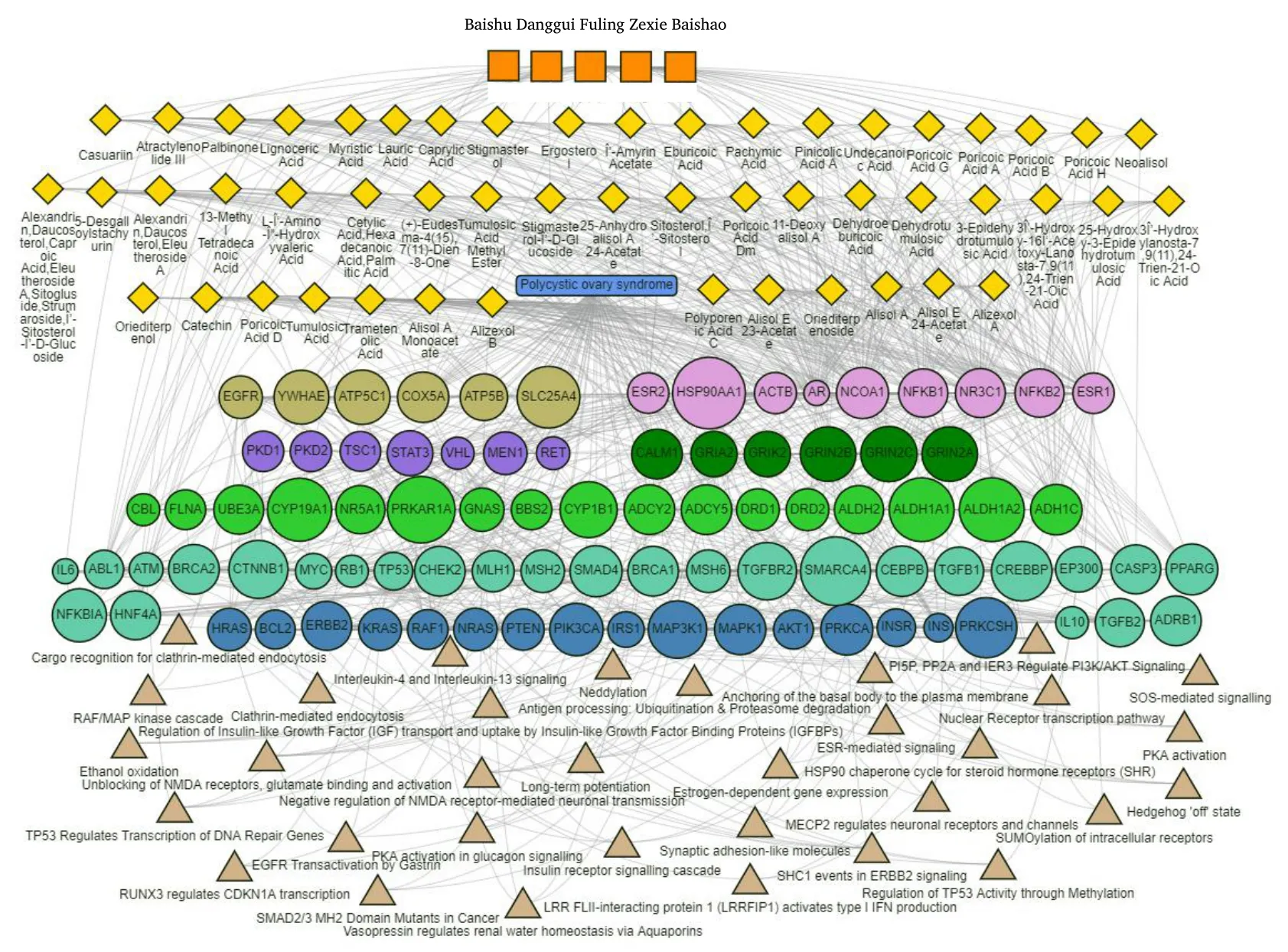Exploring the mechanism of action of Danggui Shaoyao San in the treatment of polycystic ovary syndrome based on integrated pharmacology and molecular docking
2022-09-15XiaoYingZhaoAnLanZhaoLiMaXuePingXiaZiXuanZhaoFangWeiWang
Xiao-Ying Zhao ,An-Lan Zhao ,Li Ma ,Xue-Ping Xia ,Zi-Xuan Zhao ,Fang-Wei Wang*
1Tianjin University of Traditional Chinese Medicine,Tianjin 301617,China.
Abstract Background: We used integrated pharmacology and molecular docking to investigate the mechanism of action of Danggui Shaoyao San (DSS) in the treatment of polycystic ovary syndrome (PCOS),and to provide a basis for subsequent systematic studies.Methods:The Integrative Pharmacology-based Research Platform of Traditional Chinese Medicine(TCMIP) V2.0 was used for target prediction of the drugs within DSS.Relevant targets for PCOS were retrieved in the human gene database (GeneCards) and imported within TCMIP V2.0.Relying on the “Chinese medicine association network mining” module in the TCMIP V2.0 platform,the “drug target-disease target” interaction network is constructed.We continue to enrich and analyze the potential targets of the above drugs for disease intervention through the TCMIP V2.0 platform,draw a multidimensional network map of“Chinese herbal medicine– chemical composition– disease– potential target– pathway”and validate the intersection of chemical composition and drug with disease by molecular docking.Results:There are 88 potential targets and 28 potential core targets among the action targets of DSS and PCOS.Combined with protein-protein interaction network analysis,the potential core targets of disease and drug intersection are estrogen receptor 1 androgen receptor.The binding energies obtained by molecular docking were all ≤-5.0 kJ/moL,indicating that the potentially active chemical components have good binding activity to the intersection targets.Conclusion:DSS has the potential to be a multi-target and multi-pathway treatment for PCOS.
Keywords: polycystic ovary syndrome;integrative pharmacology;molecular docking;insulin resistance
Highlights
This paper explored the mechanism of action of Danggui Shaoyao San in the treatment of polycystic ovary syndrome based on integrated pharmacology and molecular docking.This study suggests that Danggui Shaoyao San may treat polycystic ovary syndrome by promoting PI3K/Akt signaling pathway activation.Polycystic ovary syndrome closely related to glycolipid metabolism.Danggui Shaoyao San may play an important role in inhibiting insulin resistance by regulating glycolipid metabolism.This needs to be verified by clinical experiments.
Background
Polycystic ovary syndrome (PCOS) is considered the most common disorder in the field of obstetrical and gynecological endocrinology and the most common cause of menstrual disorders and even infertility in adolescent and reproductive age women [1–2].The main clinical manifestations of PCOS are obesity,hirsutism,sex hormone disorders,insulin resistance (IR),hyperinsulinemia,and infertility,which are incurable and lifelong and seriously affect women’s physical and mental health [3,4].
Clinical treatment for PCOS in western medicine includes lifestyle improvement,pharmacological treatment and surgical treatment and improve patients’ lifestyles by intervening in their diet,exercise and behavior.Drug therapy is divided into hormonal contraceptives,insulin sensitizers and hypoglycemic agents,but drug therapy may lead to fetal teratogenicity,gastrointestinal reactions,myocardial damage,and congestive heart failure [4–7].Surgery is the treatment mainly includes laparoscopic ovarian perforation,follicular puncture and ovarian wedge resection,but it is an invasive approach with postoperative adverse effects of pelvic and abdominal adhesions and premature ovarian failure [4].Traditional Chinese medicine (TCM)uses Chinese herbal medicine,acupuncture and acupuncture point burial to treat the disease with diversified treatment methods,taking into account the symptoms and the root cause,and with long-lasting efficacy [3–4].One of the internal Chinese medicine formulas,Danggui Shaoyao San (DSS),is derived fromThe Synopsis of Prescriptions of Goldenand consists ofAngelica sinensis(Danggui),Radix Paeoniae alba(Shaoyao),Rhizoma atractylodis macrocephalae(Baizhu),Poria cocos(Fuling) andRhizoma alismatis(Zexie),and is used to treat “abdominal pain in pregnancy” and “pain from various diseases in the abdomen” [8].Related studies have confirmed the ameliorative effect of DSS on PCOS [9].In this study,we used an integrated pharmacological platform and molecular docking to explore the mechanism of action of drugs within DSS,providing theoretical support for the development of subsequent systematic studies.
Information and methods
Collection of chemical components and targets of Angelica paeoniae powder
The chemical constituents (including formulae) of the Chinese herbal medicines were respectively retrieved with the keywordsAngelica sinensis(Danggui),Rhizoma atractylodis macrocephalae(Baizhu),Radix paeoniae alba(Shaoyao),Poria cocos(Fuling) andRhizoma alismatis(Zexie) from the target prediction and functional analysis section of the TCM integrated pharmacology research platform Integrative Pharmacology-based Research Platform of Traditional Chinese Medicine (TCMIP) V2.0 (http://www.tcmip.cn/TCMIP/index.php.).The platform,on the other hand,searches the two-dimensional structures of Chinese herbal ingredients with certified drugs in DrugBank for structural similarity and scores the similarity with Tanimoto coefficients.In this study,the similarity score ≥0.8was set as the screening criterion to obtain the chemical composition of the Chinese herbal medicine DSS and construct the corresponding drug target set [10,11].
Polycystic ovary syndrome target collection
Since the TCMIP V2.0 platform has too few disease-related genes related to PCOS,it does not meet the conditions for network analysis.Therefore,in this study,we searched the human gene database(GeneCards,https://www.genecards.org/) with “polycystic ovary syndrome” as the keyword and filtered by “relevance score >10” to obtain the disease targets of PCOS and import them into the disease database of TCMIP V2.0 platform and used the disease related molecule set and its function mining function of TCMIP V2.0 platform to select “polycystic ovary syndrome” as the clinical phenotype of PCOS to obtain the disease targets and construct the disease target set[12].
Protein-protein interaction (PPI) network and key target screening
Based on the “TCM association network mining” module of TCMIP V2.0 platform,we obtained the target protein interaction network.The values of degree,closeness and betweenness in this network are calculated and the potential nodes in this network are filtered by taking the median of Degree twice as the card value;on this basis,a sub-network is constructed to obtain the potential core targets of this network by satisfying the screening condition that The values of degree,closeness and betweenness are all greater than the median at the same time.
Gene Ontology (GO)and reactome pathway enrichment analysis
In this study,the“TCM association network mining”module in TCMIP V2.0 platform was used to perform gene function GO analysis and signaling pathway reactome pathway enrichment analysis on the key targets obtained under “1.3”.The results of the top 20 ranked biological processes in GO enrichment and reactome pathway enrichment were obtained according to theP-value ranking and further analyzed the role played by these signaling pathways in the mechanism of DSS to interfere with PCOS.
Construction of multidimensional network diagram
Based on the data obtained from the TCMIP V2.0 association network analysis,a multidimensional network diagram of “Chinese herbal medicine– chemical component– disease– potential core target–pathway” was constructed to predict the association between DSS and PCOS,and to screen the chemical components according to theirP-values.
Results
Target collection of Angelica paeoniae paste
Through TCMIP V2.0 platform,the chemical composition ofAngelica sinensis(Danggui),Rhizoma atractylodis macrocephalae(Baizhu),Radix Paeoniae alba(Shaoyao),Poria cocos(Fuling) andRhizoma alismatis(Zexie) were queried by the Chinese herbal medicine database.Among them,Angelica sinensis(Danggui) contains 65 chemical components,Rhizoma atractylodis macrocephalae(Baizhu) contains 20 chemical components,Radix paeoniae alba(Shaoyao) contains 54 chemical components,Poria cocos(Fuling) contains 33 chemical components andRhizoma alismatis(Zexie) contains 31 chemical components.After the two-dimensional structural similarity search of the above chemical components,the candidate target profiles of Chinese medicine with high confidence (Similar Score >0.8) were obtained and de-weighted and 635 target proteins of DSS were obtained,and the information of some chemical components of DSS is shown in Table 1.
Collection of genes associated with polycystic ovary syndrome
The TCMIP V2.0 platform provides little information on PCOS-related targets,so we searched for PCOS disease targets in the human genetic database using “polycystic ovary syndrome” as the keyword and filtered by “relevance after filtering” by “relevance score >10”,a total of 233 targets were found.These targets were uploaded to the backend database of TCMIP V2.0 platform for subsequent network analysis.
PPI network construction and potential therapeutic target screening
Based on the PPI database mosaicked by TCMIP V2.0 platform,the interaction network between drug and disease target is constructed,see Figure 1,in which the dark green square nodes represent the drug,the blue rectangular nodes represent the disease,the green circular nodes represent the drug target,the red circular nodes represent the disease target,the purple circular nodes represent the disease-drug co-action target and the connecting lines represent the existence of the two nodes between interaction.In TCMIP V2.0 set the median of 2 times the degree of the nodes that simultaneously meet greater than this network as the card value,a total of 88 potential targets of the PPI network of drugs and diseases were selected.On this basis,the medians of degree,closeness and betweenness were calculated as 16,0.208 and 484.423,respectively;and the cardinal values were used to construct the sub-network,and a total of 28 potential core targets were obtained,and the information of this target is shown in Table 2.

Table 1 Chemical constituents of prescription

Figure 1 Disease-drug interaction network

Table 2 Potential core target information
GO and reactome pathway enrichment analysis
Based on GO and Reactome Pathway database,gene and pathway enrichment analysis was performed for the potential targets corresponding to the chemical components of the herbs within DSS and the top 20 entries were sorted according to theP-value size and displayed.GO enrichment analysis revealed that the potential drug-disease targets are mainly related to positive regulation of transcription,DNA-templated,positive regulation of transcription by RNA polymerase II,negative regulation of cell proliferation,positive regulation of gene expression and activation of mitogen.transcription by RNA polymerase II,negative regulation of cell proliferation,positive regulation of gene expression,activation of mitogen mitogen-activated protein kinase cascade,intrinsic apoptotic signaling pathway in response to DNA damage,response to drug and other biological processes,see Figure 2.
Reactome pathway results showed that key targets were mainly enriched in constitutive signaling by EGFRvIII,constitutive signaling by Ligand-Responsive EGFR Cancer Variants,CD209 (DC-SIGN)signaling,insulin receptor signalling cascade and gastric receptor signalling.Responsive EGFR Cancer Variants,CD209 (DC-SIGN)signaling,insulin receptor signalling cascade,EGFR Transactivation by Gastrin,PI5P,PP2A and IER3 Regulate PI3K/AKT Signaling (PI5P,PP2A and IER3 regulate PI3K/AKT signaling in the signaling pathway,see Figure 3.
Multidimensional association network analysis of “Chinese herbal medicine -chemical composition -disease -potential target -pathway"
Relying on the TCMIP V2.0 association network mining module,we organized the association relationship between the above data and drew a multidimensional network diagram of “Chinese herbal medicine– chemical composition– potential target– pathway”,see Figure 4,in which orange square nodes represent herbal medicine,yellow diamond nodes represent chemical composition of herbal medicine,blue rectangular nodes.The orange square nodes represent herbs,yellow diamond nodes represent chemical components of herbs,blue rectangular nodes represent diseases,circular nodes represent potential targets,brown triangular nodes represent pathways and connecting lines represent the existence of links between nodes;and the chemical components of herbs were screened according to the number of connected targets,and the top ten chemical components were selected as potentially effective chemical components.

Figure 2 GO enrichment of drugs and potential targets of PCOS.GO,Gene Ontology;PCOS,polycystic ovary syndrome.

Figure 3 Reactome pathway enrichment analysis of drugs and potential targets of PCOS.PCOS,polycystic ovary syndrome.

Figure 4 Multidimensional network diagram of“Chinese herbal medicine-pharmacodynamic components-diseases-potential targetspathway”.
Molecular docking
According to the results in Figure 1,Table 2 and Figure 4,androgen receptor (AR),estrogen receptor 1 (ESR1) is not only a target for disease and drug co-action,but also belongs to the range of potential core targets,so AR,ESR was finally selected as the target.Molecular docking of potentially active chemical components to drug-disease intersection targets was performed using AutoDock Vina and binding energies were calculated for each molecular docking result.The lower the binding energy,the stronger the binding of the chemical component to the target.Binding energies less than–5.0 kJ/moL are generally considered to indicate good binding activity and less than–7.0 kJ/moL indicates strong binding activity [13].The results showed that all 20 molecules of the chemical composition and the target had docking binding energy ≤–5.0 kJ/moL and 16 molecules had strong binding activity with docking binding energy ≤–7.0 kJ/moL and the detailed results are shown in Table 3.

Table 3 Molecular docking results of potential effective chemical composition and target
Discussion
The ancient medical literature does not mention the name of PCOS,but according to its clinical manifestations it can be classified as “late menstruation”,“menorrhagia”,“amenorrhea”,“infertility” and“prolonged menstruation” [14].Modern medical practitioner Professor Zhang believes that PCOS is closely related to the liver,spleen and kidney,with kidney deficiency as the basis,accompanied by spleen deficiency or liver depression [15].Professor Min-Ru Liu,a master of Chinese medicine,combined the research on PCOS by ancient physicians and modern scholars of western medicine and named PCOS as “evidence of congestion of lipid membranes in the cell”,which summarized the location,causes,pathogenesis and clinical manifestations of PCOS [16].Professor Yan-Xia Liu advocated the theory of “warmth is biology” in the treatment of PCOS and the sequential therapy of tonifying the kidneys and regulating the circumference is used throughout the treatment,and the protocol is adjusted appropriately with the diagnosis and treatment [17].In summary,the pathogenesis of PCOS is kidney-based,but it can also involve other organs to present with concurrent evidence.
Exploration of the mechanism of DSS for PCOS
Combined with the results in Figure 1 and Table 2,ESR1,AR is the intersectional target of DSS and PCOS.Related studies confirmed that ESR1 regulates the expression of estrogen receptor alpha(ER-α),a key receptor for maintaining ovarian granulosa cell differentiation,follicle and oocyte growth and development,and ovulation function,and its abnormal function is closely associated with PCOS [4].ER-α has significant effects on mood and cognition,changes in estrogen regulate mood,and decreased levels of estradiol can affect ER-α expression,thereby increasing susceptibility to anxiety-like mood [18,19].In a study,it was noted that PCOS is closely associated with negative emotions and that patients with PCOS are more likely to have emotional abnormalities such as depression and anxiety [20].
The androgen receptor (AR) regulates many pathological manifestations of PCOS and androgens are required to exert their effects through the AR [21].Studies have shown that androgens promote elevated blood androgen levels in anovulatory model animals(ASR) and upregulate AR expression in the pancreas,hypothalamus and ovaries,causing hyper-LHemia and anovulation in this model[22,23].Caldwell et al demonstrated that the removal of neurogenic AR completely protects against the manifestation of PCOS caused by prepubertal dihydrotestosterone overexposure in female rats [24].
Combining the results in Table 2 and Figure 3,insulin receptor signalling cascade,PI5P,PP2A and IER3 regulate PI3K/AKT signaling(PI5P,PP2A and IER3 regulate PI3K/AKT signalling pathway) are more closely related to PCOS.insulin receptor substrate 1 (IRS1) is a tyrosine kinase substrate of the insulin receptor,an important signaling molecule in the initiation of insulin receptor signaling,and is closely related to IR [25,26].When IRS1 tyrosine phosphorylation is diminished and serine phosphorylation is enhanced,its protein undergoes abnormal phosphorylation expression and insulin signaling is disturbed leading to the development of insulin resistance [26].IR causes hyperinsulinemia and can inhibit estradiol synthesis,leading to impaired follicular development and abnormal ovarian morphological function [27].The PI3K/Akt signaling pathway is an important pathway affecting the development of IR [28].AKT is a target protein downstream of PI3K and phosphorylation of AKT can contribute to follicular cell proliferation and abnormal follicular development or even anovulation,which can lead to PCOS [29].When p-AKT expression is diminished,insulin signaling is decreased,Glut4 expression is reduced and the body’s function of glucose uptake and utilization is diminished,leading to IR.Abnormal insulin metabolism,decreased IRS1 tyrosine phosphorylation,interference with PI3K activation and inhibition of Glut4 transport can also induce IR [26].One study found that the expression level of PI3K was significantly decreased in granulosa cells of patients with PCOS with insulin resistance[30].
Based on the results in Figure 4 and Table 3,it is suggested that naringenin,atractylenolide Ⅲ,liquiritigenin,flavonol,5-desgalloylstachyurin and oriediterpenol may be potentially effective chemical components of DSS for the treatment of PCOS.Naringenin is an important dihydroflavonoid active ingredient found in Citrus spp and is widely present in various plants or herbal medicines [31,32].Naringenin has anti-inflammatory,antioxidant,improves glucolipid metabolism and promotes estrogen synthesis [32,33].One study confirmed that naringenin exhibited antioxidant and steroidogenic enzyme activity in a rat model of PCOS,thereby regulating glucolipid metabolism and hormonal disorders[34].Xu Jing et al.found through animal experiments that naringenin could inhibit elevated glucose and lipids and reduce IR by promoting PI3K/AKT pathway activation,thereby improving sex hormone disorders and ovarian polycystic changes in PCOS rats [33].Atractylenolide III is an extract of the traditional Chinese medicineAtractylodes macrocephala,which has various effects such as anti-inflammatory,anti-tumor and neuroprotective [35].One study found that Atractylenolide III has anxiolytic and depressive effects in Lipopolysaccharide-induced acute depression model and chronic unpredictable mild stress depression model in Sprague-Dawley male rats [36].Atractylenolide III exerts a significant inhibitory effect on platelet aggregation and secretion by inhibiting AKT phosphorylation in the PI3K/AKT signaling pathway,thus acting as an inhibitor of platelet activity [37,38].It is suggested that atractylenolide III may play a role in the treatment of PCOS through PI3K/AKT signaling pathway.Glycyrrhizin is a flavonoid extracted from the Chinese herbal medicineGlycyrrhiza glabrawith antitumor effects,estrogen-like effects and anti-inflammatory effects[39].A related study found that glycyrrhizin reduced ovarian mass and normalized ovarian tissue morphology in letrozole-induced PCOS rats and it also reduced serum luteinizing hormone levels,increased estradiol levels and decreased testosterone levels in rats [40].
Conclusion
In conclusion,this study used various data analysis and processing methods to analyze the relevant chemical composition,potential targets and signaling pathways of the drugs within DSS,and elaborated on their chemical composition,potential targets and signaling pathways for the coordinated treatment of PCOS,providing basic ideas for the treatment of PCOS and new ideas for subsequent systematic studies.However,this study still has shortcomings and is only based on the predicted results of existing studies,which need to be verified in combination with clinical trials.
杂志排行
Drug Combination Therapy的其它文章
- Mechanism of Liangxue Huayu decoction in treatment of age-related macular degeneration based on network pharmacology and clinical validation
- Significance of Siddha traditional oil bath(ennaimuzhukku)-a review article
- Clinical efficacy of Qingre Quzhuo capsule in the treatment of non-alcoholic fatty liver disease
